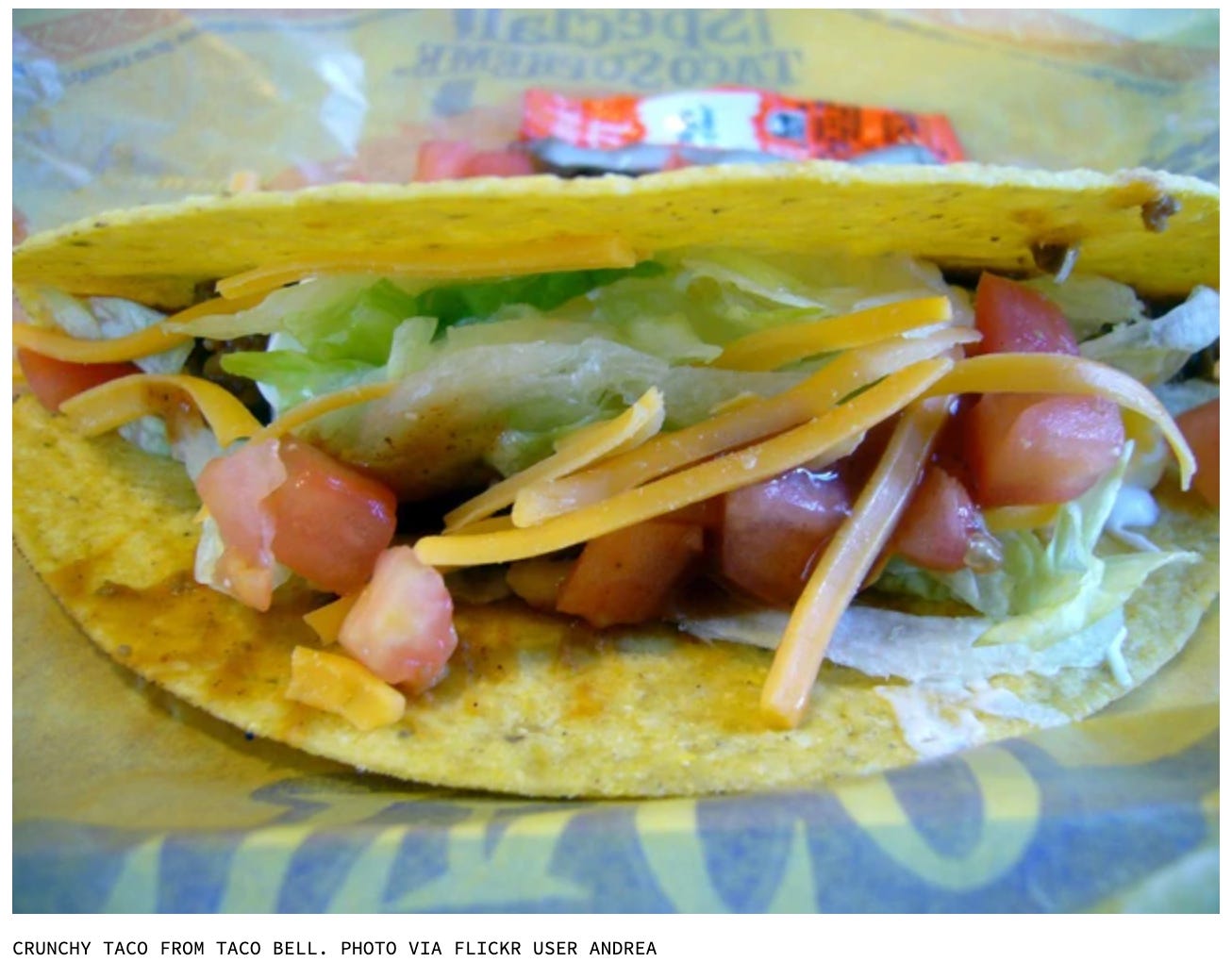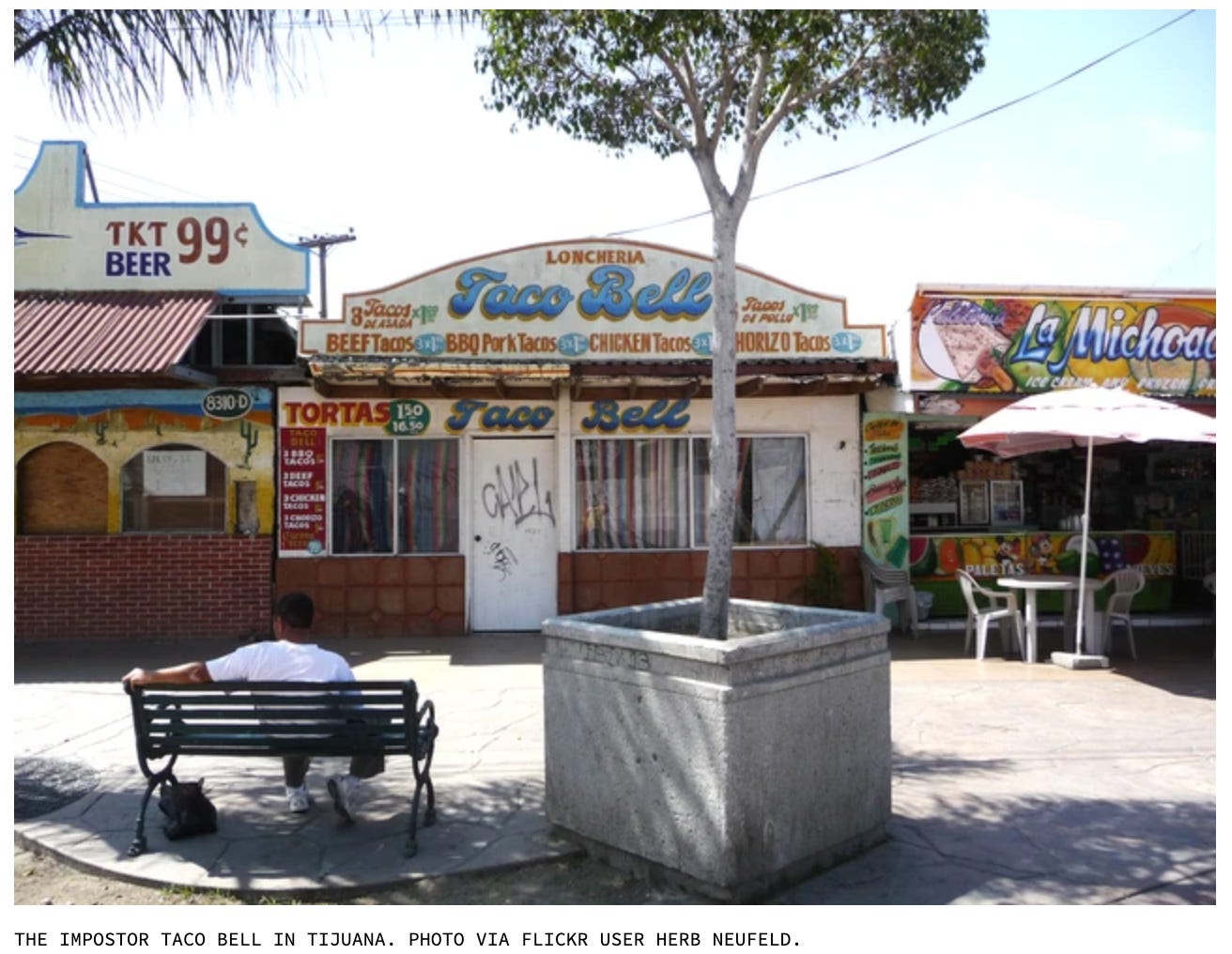I remember listening to an episode of “Revisionist History,” Malcolm Gladwell’s podcast about history forgotten or misremembered. This episode, believe it or not, was about the story of Taco Bell. The reason it’s called Taco Bell is that it was founded by…wait for it…Glen Bell (1923-2010) in Irvine, CA. The history of Taco Bell follows the pattern of many fast food franchises, so I’ll spare my reader the dry recitation of how Taco Bell became bigger than Jesus and about as Mexican as my mother’s fried bologna sandwiches.
Glen Bell excelled at not being tied down to the idea of what Mexican food was all about. Sure, Taco Bell started with “Mexican-inspired” food, and much of its menu today continues to be “Mexican-inspired.” The only difference is the degree of inspiration and how thoroughly Americanized Taco Bell’s food has become over the past five decades. Today, most of Taco Bell’s menu is as Mexican as hummus and pita bread.
Bell was good at making money, so he tinkered with recipes and observed how his customers reacted. What they liked, he kept and adapted. What they weren’t so keen on, he discarded. As his restaurants because increasingly popular, they became more American and the fare less recognizably Mexican.
Even so, you’d think that Taco Bell, a chain that supposedly made its reputation and fortune off Mexican food, would be able to carve out a niche in the country of its cuisine’s origin.
Ah, not so fast, amigo. It turns out that making it in Mexico was a very long trip on some long and awful roads. Translation: No hay Taco Bells en México.
That's right: There are no Taco Bells in Mexico. But that sure as hell isn't for a lack of trying. And then trying again.
Taco Bell's forays into Mexico started back in 1992, when the chain had only around 3,700 restaurants, the vast majority of which were in the US. The company made its first stab at the Mexican market with a food cart in Mexico City, which served a limited menu of soft-shell tacos and burritos, along with Pepsi, the chain's corporate owner at the time. A few other outlets were briefly opened next to KFC locations.
Problems arose from the get-go. The wildly inauthentic names of several popular Taco Bell items had to be changed because Mexican customers didn't understand what exactly they were ordering. For instance, the crunchy taco—an anomaly in Mexico—had to be re-branded the "Tacostada," thereby evoking the crunchiness of a tostada in taco form.
The problem was that Taco Bell’s menu had strayed so far from its Mexican roots- such as they were- that Mexicans couldn’t recognize the food as authentically Mexican.
Because it wasn’t anywhere near being authentically Mexican.
Taco Bell’s first foray into Mexico failed because they couldn’t convince the natives that their bastardized, imitation Mexican food was the real thing. It was like trying to fool Americans into believing that hamburgers made of camel meat are the real thing.
[T]he Mexican population wasn't buying it. One iconic comment on the issue came from Carlos Monsivais, a cultural critic, who spoke to the Associated Press at the time and dubbed the attempt to bring tacos to Mexico "like bringing ice to the Arctic." In short order, the first Taco Bells in Mexico were shut down less than two years after opening and the chain retreated back across the border.
So Taco Bell returned to doing what it was good at north of the border. Then, almost 15 years later, the company was ready to try again. Either the company was newly confident, or the institutional memory had faded enough to be once again replaced by hubris and overconfidence.
And so they headed south of the border again.
[B]y the mid-aughts, Taco Bell was ready to try to break into the Mexican market once again. In 2007, when the fast-food company opened another outlet south of the border, the Chicago Tribune wrote that the move meant "the cultural walls fell for good." Hopes were high; after almost a 15-year absence, Taco Bell could once again be found in our southern neighbor Mexico—this time next to a Dairy Queen in the parking lot of a fancy shopping mall just outside of Monterrey.
This time around, Taco Bell wasn’t even pretending to be Mexican food. They weren’t competing with taquerias. No, they were going to be something different.
Their branding strategy was simple but intended to make clear what they were trying to do: “Taco Bell is something else.”
The question was, “What else?”
The first Monterrey location encountered considerable skepticism. One American wag said, “It's like Mexicans coming up and trying to sell us hot dogs.” Mexican customers were decidedly unimpressed.
Once again, it seemed that stupid gringos were trying to sell Mexicans poor-quality, not quite Mexican food- and the locals could see right through it.
Marco Fragoso, an office worker remarked to the Associated Press at the time, "They're not tacos. They're folded tostadas. They're very ugly." Another customer, Jonathan Elorriaga, told the AP reporter, "Something is lacking here. Maybe the food shouldn't come with French fries."
A food writer for Monterrey's El Norte newspaper summed it all up with the following: "What foolish gringos. They want to come by force to sell us tacos in Taco Land. Here, they have a year in operation and the most ironic part is that they are doing well. Are we malinches [a Mexican term for traitor] or masochists?"
And so Taco Bell’s second foray into Mexico inevitably crashed and burned in humiliating fashion. It was as if the company had learned nothing from its first flame-out, and here they were, packing up and heading back north of the border again.
Taco Bell has refrained from returning to Mexico, focusing instead on countries where they're not competing with the locals’ idea of what a taco should be. After all, Mexicans invented tacos.
[P]undits tried to explain the debacle. Some chalked the second failure up to the political climate in 2007: the mid-aughts were indeed an era of tougher enforcement of immigration laws and the inability to pass temporary-worker laws in the US. Meanwhile, Taco Bell's contemporaneous move into the China market—where the outlets served soy milk and plum juice—was much more successful than the chain's second attempt to sell Mexican food to Mexicans.
Taco Bell has stayed out of the Mexican market ever since. Today, the idea of a Taco Bell in Mexico has become something of a joke. There's even a Facebook page for a non-existent Taco Bell in Mexico City that has a one-star review and is littered with comments deriding the chain. One Facebook user from Culhuacán left a comment on the page saying "NO SON TACOS, SON CHINGADERAS," which translates to "They are not tacos, they are trash." In a TripAdvisor post asking what ever happened to the Taco Bell in Mexico City, a user from Mexico City wrote the following: "In 29 years I've never seen a Taco Bell in Mexico City… or in Mexico, although I could be wrong. I agree to bring a Taco Bell here it's a pretty bad idea. Taco Bell… is everything but Mexican food."
Chalk Taco Bell’s failure to survive in Mexico up to hubris, overconfidence, and an inability to understand the Mexican market. Still, the biggest reason may be one on which no one seems willing to focus- Taco Bell’s menu is full of genuinely awful fast food.
I can’t speak from experience, but I have the experience of plenty of friends with which to work. I’ve been to a few Taco Bells, but I’ve never been able to bring myself to eat the food. I’ve heard enough jokes about the impact of Taco Bell food on digestive tracts that I steer clear of their food (and fast food generally).
There is one remaining Taco Bell in Tijuana, though it has no affiliation with the American chain. That’s probably a good thing because, if Yelp reviews are to be believed,
this Taco Bell has no running water, the bathrooms are "disgusting," and there are flies aplenty. But the beers cost a buck, and the tacos are legit street-style—and truthfully don't sound bad at all.
Honestly, that sounds legitimately (and awesomely) Mexican, the sort of place where you can get lunch- and all the Montezuma’s Revenge you can handle- for less than $5. Helluva deal, no?
Hey, if you want to have diarrhea in Mexico, why not go native? Why rely on bad American faux-Mexican food?
In the end, nothing better encapsulates the Sisyphean task that was trying to convince proud Mexicans that they should willingly ditch the nation's countless taquerias in favor of an American fast-food chain than Taco Bell's no-longer-used "run for the border" slogan. After all, each time Taco Bell attempted an ill-advised foray into Mexico, the result was a mad dash back to the States.
Because what could be LESS Mexican than a menu filled with Naked Chicken Chalupas, Nacho Crunch Grilled Stuft Burritos, Spicy Chicken Crunchwrap Supreme, Chicken Caesar Grilled Stuft Burritos, etc., ad nauseam? Literally.
Even the most gullible Mexican citizen would look at a Taco Bell menu and wonder, “WTF is this fresh Hell???” And they’d have good reason to wonder whether American business people are all that intelligent.
So now Taco Bell focuses on countries where a Chicken Caesar Grilled Stuft Burrito is a novelty and seems as Mexican as anything else. You can find Taco Bells in Cyprus, China, Finland, Costa Rica, and Portugal, to name a few countries; it’s a very long list. When I was in Iceland, I was appalled when I walked past a Taco Bell in Reykjavik. My first thought was, “Is NOTHING sacred?”
The answer, of course, is “Evidently not.”
Sometimes, I’m embarrassed to be an American.








"Taco Hell"
There's a place a few miles up from where I live that sells (only on Thursdays) what they call "street tacos," and what I would add are "fusion." Not really Mexican, but not really bad, either. I like that their jalapenos are always fresh.
Back in the '60's, in San Diego, when Mexican cuisine was first gaining in popularity, my mother decided she wanted to learn how to do some of those dishes. As a result, along side fried chicken, I can legit name Chili Rellanos as comfort food. You damned sure won't find those at Taco Hell.